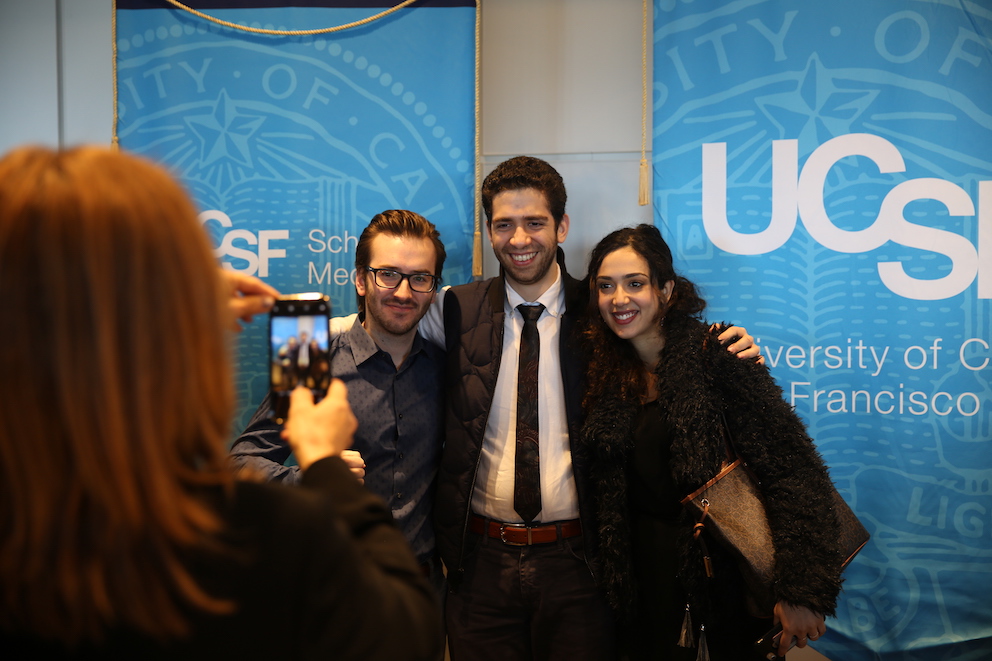On Match Day, Students Reflect on UCSF’s Culture of Innovation and Commitment to Advancing Research

Students at Match Day 2019
Match Making History
After four years of classes, clinics and exams, 169 UCSF School of Medicine students will graduate and embark on the next phase of their medical careers this May.
At 9 a.m. Pacific Time on March 15, students broke the seals on their match envelopes and the Millbury Union was filled with exclamations of joy and relief, as students learned where they will spend the next three to seven years in residency training programs.

Match Day is part of a tradition that takes place annually on the third Friday of March, with medical school students across the country learning their residency placements as part of the National Resident Matching Program (NRMP).
This year’s match was the largest on record. In 2019, 18,925 graduating allopathic medical students from across the country and 16,561 graduating international and osteopathic medical students, as well as Americans studying abroad, competed for some 35,000 residency positions, the most ever offered in Match history, according to the NRMP.
The matching process began last spring when students decided on their specialties, registered and submitted applications. They interviewed throughout the winter and in February submitted a ranking of their choices, based on their desired specialty and geographic location. In fall, residency programs reviewed applications and invited shortlist candidates to interview, and then created their own rankings in advance of Match Day.
Commitment to California
This year, all 169 graduating UCSF School of Medicine students matched to clinical training, internship or residency programs at hospitals. Sixty-nine, or 41 percent of the class, were accepted to fields related to primary care and the other 59 percent matched in non-primary care specialties.
Sixty-four percent of the class will continue their medical education journeys in the Bay Area and across the state. The rest of the class will complete their training in leading hospitals in 19 other states across the country.
“UCSF is a unique intersection of physicians who are really committed to their communities and draw on the Bay Area’s culture of innovation and research,” said Karolina Plonowska. “I’m excited to take this next step towards becoming a physician scientist and to be staying at UCSF to continue working on the projects I’ve started here.”

Advancing Research
“I decided to pursue research at UCSF because I’m passionate about education – I have always loved teaching,” said Justin Bullock. “UCSF is a very special place that goes beyond teaching to education scholarship – what does it mean to teach and assess correctly? What are the best practices to education students?”

Justin is one of 54 students who will be staying at UCSF for residency. The School of Medicine was recently ranked the fifth-best for medical research nationally, and this year’s admitted class will continue the legacy of excellence. Over the last decade, the Department of Medicine has ranked at or near the top among all departments of medicine in research dollars granted by the National Institutes of Health (NIH). Continued accomplishments in this highly competitive arena attest to the quality and significance of the research performed by basic and clinical scientists. Important for this success is the research environment at UCSF, which, along with its collaborative culture, affords virtually unlimited opportunities for interdisciplinary research and education.
Success in the Medical Scientist Training Program
Every year, the MD/PhD Medical Scientist Training Program graduates 10-12 physician scientists who will pursue outstanding careers in academic medicine and research.
“My work [in the MSTP] really positioned me well going forward, it gave me a set of tools to ask questions about how we can treat disease that are pretty unique. Having the knowledge of medicine, and of the biology, but also being able to work with small molecules and potentially make drug-like molecules will allow me to advance things forward,” said Geoff Smith. “Especially in a field like childhood cancers where there's not necessarily going to be a huge pharma motivation to develop new compounds, I think we're going to have to do a lot more of that in academia. I think I've been well-positioned by my training here at UCSF to hopefully be a part of that.”
The MSTP program, which takes just over eight years to complete, generally consists of two pre-clerkship years of medical school, followed by four years of graduate research leading to a doctoral dissertation, and the final five quarters of medical-school clinical clerkships. The program is funded by the NIH, the School of Medicine, and the UCSF Graduate Division.
“Graduates of our program are some of most sought-after candidates for residency in the country, because of their commitment to both research and clinical care. The combined MD/PhD degree program gives these students an incredible foundation for being the next generation of physicians that will make discoveries that impact patient care” said Dr. Mark Anderson, who serves as Director of the UCSF MSTP.
